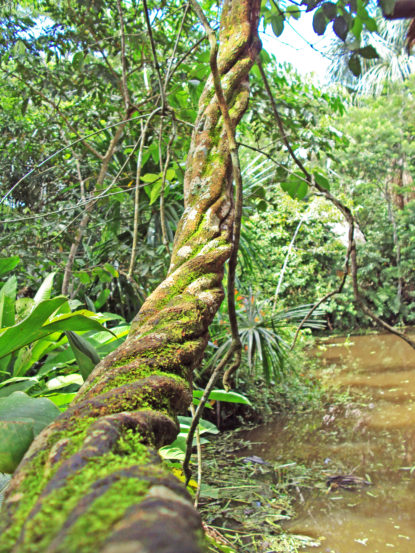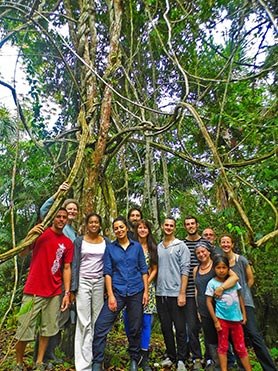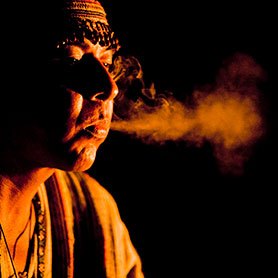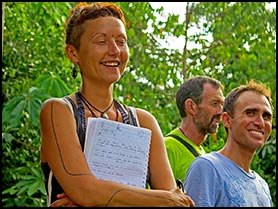
Ayawaska: Spirit Vine
Ayawaska, more commonly spelled “ayahuasca”, refers to a plant medicine used by over 90 different indigenous tribes in the Amazon Rainforest. Each community has developed healing traditions based sacred use of this plant and mixture. This number becomes even more impressive when one considers the fact that many of these tribes live thousands of miles apart and would appear to have never had contact with each other. Within the philosophy of each tribe, one point remains consistent, which is that they originally learned about the science of plant medicine from the plants themselves.
Both the plant and the medicine prepared from it are called “ayawaska” or “ayahuasca”.
What is Ayawaska/Ayahuasca?
Scientific Name : banisteriopsis caapi
Common Names in the Amazon: ayahuasca; yagé; bejuco; caapi; nucnu huasca; shimbaya huasca; nishi; oni; népe; xono; datém; kamarampi; pindé; natema; iona; mii; shillinto; nepi.

The admixture plants most often used are the leaves of chacruna (Psychotria viridis) and yagé; also known as chaliponga, chagraponga, and huambisa (Diplopterys cabrerana). Ayahuasca is known and used throughout Perú, Ecuador, Colombia, Bolivia, and western Brazil. The use of ayahuasca is rapidly gaining awareness and acceptance throughout the world thanks to retreat programs and organized religious movements such as Santo Daime and the União do Vegetal (UDV), who won a supreme court decision for the right of members to use the sacred medicine in ceremonies in the United States.
Ayahuasca has been used in the Peruvian Amazon for millenia, long before the Spanish came to Peru, before the Incan Empire was formed, before history. The oldest known object related to the use of ayahuasca is a ceremonial cup which dates to a culture that ended in the year 50 A.D. Carved out of stone with engraved ornamentation, it was discovered in Ecuador and currently rests at the Ethnological Museum of the Central University (Quito, Ecuador). In the Peruvian Amazon, its use dates back much further.
Chemically speaking, the medicine usually contains both beta-carboline and tryptamine alkaloids. However, some indigenous Amazonian cultures, like the Yahua, prepare their ceremonial brew using only the ayahuasca vine. The ayahuasca vine contains the beta-carbolines (harmine, harmaline, and tetrahydroharmine). Harmine and harmaline are visionary at high levels, but at a modest dosage typically produce mainly tranquility and nausea. Tetrahydroharmine is present in significant levels in ayahuasca, which may be responsible for some of its more profound effects.
Even though all ayahuasca vines are botanically classified as Banisteriopsis caapi, the curanderos classify them further, in reference to their effects. An example is cielo ayahuasca, which means sky or heaven ayahuasca, implying that its effect is of bringing one to celestial realms. Negra ayahuasca, or black ayahuasca, would be used to work specifically with darker energies, shadow selves, or black magic.
Harmala alkaloids have the unique effect of temporarily reducing levels of monoamine oxidase in the body. Monoamine oxidase is an enzyme that normally breaks down tryptamine alkaloids, among others. Monoamine oxidase inhibitors (MAOIs) thus make tryptamines orally active. Therefore, the ayahuasca plays an essential role in the brew, opening the door for a host of powerful alkaloids to reach the brain before eventually being broken down by other means.
The principal tryptamine found in ayahuasca is DiMethyltryptamine, or DMT. This naturally-occurring biochemical substance is believed to be secreted by the human brain in the pineal gland, especially when dreaming. Rick Strassman, author of ‘DMT Spirit Molecule’ theorized that 49 days into the development of the human embryo, the pineal gland produces a much larger amount of DiMethyltriptamine than normal. The only other time this occurs naturally is at the moment of our death. Therefore, Strassman concluded that the production of DMT is a chemical expression of a spiritual event, namely the entering and exiting of the spirit into and from the physical body. DiMethyltriptamine can be found in countless plant and animal species throughout the world.
While some scientists might describe the Ayahuasca experience as merely an oral DMT experience activated by a beta carboline MAO inhibitor, this description is not accurate. The dynamics within the ayahuasca experience are far more complex, due at least in part to the ayahuasca vine itself which is often said to lend ‘wisdom’ to the experience. This idea is supported by nearly every culture that uses ayahuasca in the Amazon Rainforest. The truth is that ayahuasca forms part of a complex healing phenomenon which is multifaceted and mysterious and which defies reductive, chemical or scientific over-simplifications. Ayahuasca is not just a ‘drug’ or ‘medicine’ that acts on a passive recipient; it is a relationship involving many factors, including the intention of the drinker, and the role of the curandero, who uses his/her experience and relationship with the spirit of ayahuasca (as well as other plants) to increase, decrease, and guide the depth of the healing.
Here is a quote from Richard Evans Shultes, one of the earliest pioneers in ayahuasca research, describing the effects of drinking a brew made only from the vine without any admixture plant:
“To this day, the natives of the north-west Amazon in Brazil and Colombia use the Banisteriopsis drink for prophetic and divinatory purposes and also to fortify the bravery of male adolescents about to undergo the severely painful yurupari ceremony for initiation into manhood. The narcosis amongst these peoples, with whom I have taken caapi on many occasions, is usually pleasant, characterized by visual hallucinations in color, which initially is very often a shade of blue or purple. In excessive doses, it is said to bring on frighteningly nightmarish visions and a feeling of extremely reckless abandon, although consciousness is not lost nor is use of the limbs unduly affected”.
The Ayahuasca Foundation is dedicated to work with ayahuasca in a safe and transformative way through out healing, education and training programs: check out our healing retreats and advanced training courses for more information.
EFFECTS OF AYAHUASCA
For millenia, a science of healing has been evolving in the Amazon, passed on orally from generation to generation, and through the plants themselves. The sacred medicine is primarily used to heal, and patients often feel the following effects:
HEALING THE BODY
Nearly everyone describes a physical cleansing or purification process, often involving vomiting or purging. Another name for the brew is ‘la purga’ because of its powerful purgative effects. It is not necessary to throw up, however, and the curandero rarely throws up when leading a ceremony.
HEALING THE MIND
It is not uncommon to experience a regression back to the situation or source of a problem or trauma. To relive the experience is to gain new understanding and insights enabling resolution or closure. Dream-like scenes where personal messages from spirits are received cause ceremony participants to re-evaluate their life course with a deeper understanding of why they are here, and what it is they need to do to fulfill their purpose.
HEALING THE SOUL
Most people who experience Ayahuasca report some sort of spiritual experience. Unfortunately, it is very difficult to describe the spiritual effects due to the lack of spirit in our language. Western culture is simply ignorant of the science of spirit that is still practiced today in the Amazon, but it is common for people to feel something that could be described as spiritual.
A truly authentic ayahuasca experience cannot be fully realized outside the natural and cultural environment of the Amazon rainforest. The tremendous plethora of medicinal plants that contribute to the healing process are only present in the Amazon region. The spirits of numerous powerful plant allies are called into the ayahuasca ceremonies by the curanderos. Their relationship with these plants is strongest in their physical presence, meaning that when surrounded by the plants of the Amazon rainforest, their presence and power is much more profound. This is not to say, of course, that highly beneficial personal results cannot be achieved using Ayahuasca in other areas of the world, but the benefits of receiving treatment involving a variety of medicinal plants in addition to ayahuasca in the Amazon rainforest is most likely to produce the deepest levels of benefit.
For more ayahuasca information, visit the websites below:
Wikipedia – Ayahuasca
Ayahuasca.com
Ayahuasca Info


